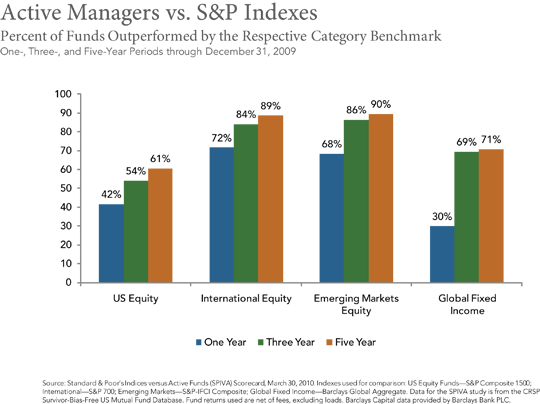Retirement Index Funds v Managed Funds
Post on: 19 Июль, 2015 No Comment

In the battle of index funds vs. actively managed funds, the winner is. well, both.
How to Pick the Best Retirement Funds
Source: ©iStock.com/EpicStockMedia
Whats the best style for retirement funds?
That question is the foundation of a constant, healthy debate behind financial minds. Some think index funds with the lowest fees are the best way to stay correlated with the market, while others are firmly entrenched in the notion that actively managed funds are the way to go.
Index investors abhor the notion of paying higher fees for stock picking strategies or uncertain risk dynamics. They don’t want to hand over the portfolio decision making to a team of experts that might place their assets in the wrong areas at the wrong times.
On the flip side, active managers tout the ability to make changes as conditions evolve to reduce volatility or enhance their exposure to thriving areas of the market. This can be a compelling argument for a retired investor that is considerably more risk averse and unwilling to sustain large losses.
In my personal opinion, you can successfully marry both types of retirement funds in your portfolio. In fact, the right mix of passive and active strategies should give you an edge in terms of capturing sustainable income, diversification and long-term growth.
Why Index Funds?
As a proponent of using low-cost ETFs, I tend to sway toward index funds as the core building blocks of a retirement portfolio. I love ETFs because they are low-cost, liquid, diversified, tax-efficient and offer a range of unique index methodologies.
Without a doubt, some of the best ETF strategies for retired investors can be found in dividend funds .
For instance, equity-income fund Vanguard High Dividend Yield ETF (VYM ) provides you with exposure to nearly 400 domestic stocks with above-average dividend yields. It does so by simply tracking the FTSE High Dividend Yield Index, and that lack of active management (plus Vanguards typical low-cost mantra ) results in a rock-bottom expense ratio of just 0.1%. In return, you get a yield of roughly 3%, paid out quarterly.
If you are looking for higher yields, an overseas dividend play such as the iShares International Select Dividend ETF (IDV ) is an excellent option. This ETF tracks an index of non-U.S. developed-market stocks, and is made up of 100 high-yield companies primarily centered around Europe, with a modest allocation to Australia as well. The current yield on IDV is 4.7%, and dividends are paid on a quarterly basis.
Why Actively Managed Funds?
For me to substitute index funds for actively managed funds, those managers strategies must show a unique value proposition in terms of asset structure or portfolio objective. If it does, I know Im using a distinctive alternative otherwise, why not just follow the benchmark?
One actively managed fund I have owned for some time now is the Pimco Income Fund (PONDX ). This multisector bond fund targets specific areas of the fixed-income market (both foreign and domestic) that the manager feels will outperform over time. In addition, PONDX has the flexibility to shift its holdings in response to the manager’s tactical outlook on credit, duration, or interest rate moves.
Right now, the PONDX portfolio has an effective duration of 3.42 years and a yield of 3.74%. This fund charges a modest 0.79% expense ratio and has consistently been in a top performer in its class since its inception in 2007.
Another actively managed mutual fund with a unique balanced approach that retired investors should consider is the Loomis Sayles Strategic Income Fund (NEZYX ). This fund is classified in the multisector bond category but has a significant allocation to traditional dividend-paying stocks, preferred stocks, high yield, convertible bonds and international holdings.
This distinctive asset mix has allowed NEZYX to outperform many traditional bond strategies with a high level of current income. In addition, the manager has the flexibility to actively size the sleeves of the portfolio according to their fundamental outlook on the stock and bond markets. According to the fund company website, NEZYX has average annualized total returns of 13.62% and 9.48% over the last five- and 10-year periods.
Bottom Line
While the debate over actively managed funds and index funds will rage on, you can make the case that every investor has unique goals that make both arguments compelling.
The ultimate decision on which funds to use in retirement should be based on your risk tolerance, time horizon and investment objectives. But no matter what, a healthy mix of both styles should lead to excellent long-term results.
David Fabian is Managing Partner and Chief Operations Officer of FMD Capital Management. As of this writing, he was long IDV, PONDX and NEZYX. Click here to download David and Michael Fabians latest special report, The Strategic Approach to Income Investing .














